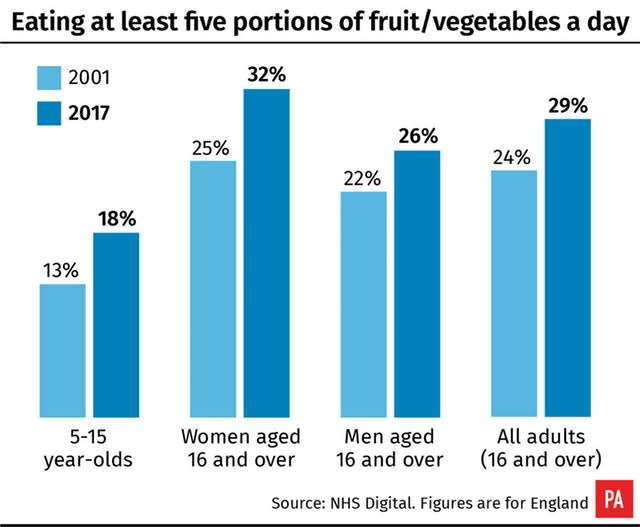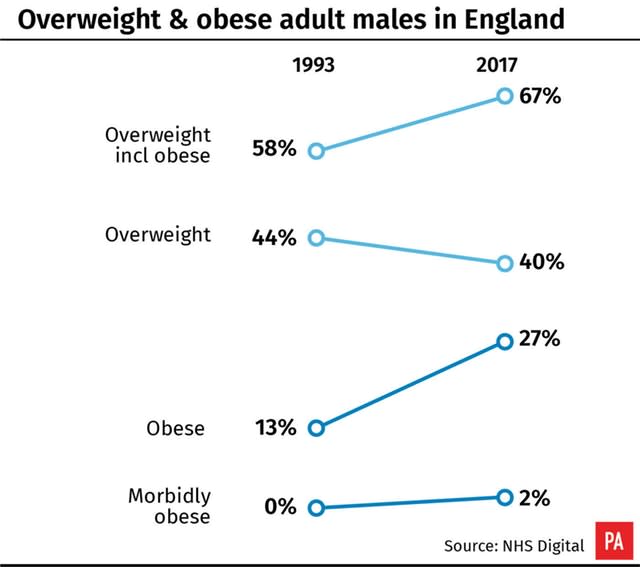Rising number of women who are morbidly obese, study shows
One in 20 women in England are morbidly obese, new figures suggest.
The new Health Survey for England shows that 64% of adults are overweight or obese.
This includes 5% of women and 2% of men who are morbidly obese – meaning they had a body mass index (BMI) score of more than 40.
In 1993, when the survey began, just 1% of women were classed as morbidly obese, according the data from NHS Digital.
It reached 5% for the first time in 2017.

People considered to be normal weight have a BMI score of 18.5 to 25, people who are overweight have a BMI score of 25 to 30 and people are considered obese if they have a BMI score over 30.
Meanwhile the survey also revealed how children whose parents are obese are also more likely to be obese themselves.
The Royal College of Paediatrics and Child Health said this was a “a cycle of life that can have terrible consequences to the health of entire families for generations”.
More than a quarter (28%) of children of an obese mother were also obese, compared with 8% of children whose mother was not overweight or obese, the figures show.
And 24% of children of an obese father were also obese, compared with 9% of children where the father was not overweight or obese.
Overall, three in 10 children aged two to 15 in England were overweight or obese in 2017.
Health Survey for England 2017 annual report released today. Headline findings include an association between parent and child obesity. Find out more in this @NHSDigital summary https://t.co/yUIZzwSGXy pic.twitter.com/qsXps9zmZW
— NatCen (@NatCen) December 4, 2018
The 2017 survey also revealed a high rate of people who have undiagnosed diabetes.
Information was gathered on 8,000 adults and 2,000 children by a survey and a nurse visit where various measurements were taken.
This included blood sugar level measurement which suggested that 20% of adults with diabetes are undiagnosed.
Meanwhile, the survey data for the first time identified the proportion of people who are not taking care of their health by leading unhealthy lifestyles.
People were quizzed about their alcohol consumption, smoking, whether they eat five portions of fruit or vegetables a day, have low levels of physical activity or are classed as obese.

Only 13% had no risk factors, but almost one in five (19%) had three or more.
Other findings from the survey include:
– One in three (34%) of adults said they were living in chronic pain.
– The proportion of adults with diagnosed diabetes increased between 1994 and 2017, from 3% to 8% among men and from 2% to 5% among women.
– The majority of people were not consuming the recommended five a day, with 29% of adults consuming five or more portions of fruit and vegetables a day and just 18% of two to 15-year-old children reaching the target.
– In 2017 the average man who drank alcohol consumed 15 units a week – exceeding the recommended limit of 14 units. Female drinkers consumed an average of 8.6 units.

The new survey also provided some figures on social care, including the proportion of adults who had some level of “unmet need”.
Researchers found that 23% of men and 28% of women aged 65 and over needed help with at least one activity such as washing, going to the toilet, getting up and down stairs or in and out of bed, eating or taking medicine.
But 20% of men and 25% of women aged 65 and over had some unmet need with at least one of these activities.

 Yahoo News
Yahoo News 
